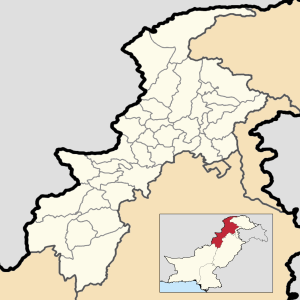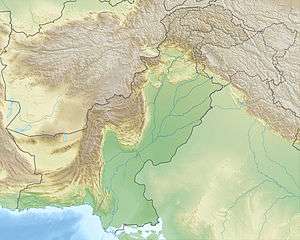Tirich Mir
Tirich Mir (Khowar/Pashto/Urdu: ترچ میر) (alternatively Terich Mir, Terichmir and Turch Mir) is the highest mountain of the Hindu Kush range, and the highest mountain in the world outside of the Himalayas-Karakoram range, located in Chitral District of Pakistan. The mountain was first climbed on 21 July 1950 by a Norwegian expedition consisting of Arne Næss, P. Kvernberg, H. Berg, and Tony Streather.[2] Tirich Mir overlooks Chitral town, and can be easily seen from the main bazaar. It is the closest mountain to Aconcagua which is higher than Aconcagua, and thus determines Aconcagua's topographic isolation.
| Tirich Mir | |
|---|---|
.jpg) Tirich Mir summit at night | |
| Highest point | |
| Elevation | 7,708 m (25,289 ft) Ranked 33rd |
| Prominence | 3,908 m (12,822 ft) [1] Ranked 30th |
| Isolation | 239 km (149 mi) |
| Listing | Ultra |
| Coordinates | 36°15′15″N 71°50′36″E [1] |
| Naming | |
| Native name | ترچ میر |
| Geography | |
 Tirich Mir Location in Pakistan  Tirich Mir Tirich Mir (Pakistan) | |
| Location | Chitral District, Khyber Pakhtunkhwa, Pakistan |
| Parent range | Hindu Kush |
| Climbing | |
| First ascent | Arne Næss, P. Kvernberg, H. Berg, and Tony Streather in 1950 |
| Easiest route | glacier/snow/ice |
The last village in Chitral before reaching Tirich Mir is the village of Tirich. This valley begins at Soorwaht , where Terich River meets Torkhow River from the west, up to Shagrom- the last permanent settlement of the valley and from there onward there are summer grazing pastures and huts of shepherds up to the snout of lower Terich glacier and goes further up to Terich Concordia where glaciers from seven sub valleys slide down and join at the Concordia. The people there speak the Khowar language. The residents are available for hire as porters and tourist guides and will lead trekkers part way up the mountain, but there is a point beyond which they will not go.
It is believed the origin of the name Tirich Mir is "King of Tirich" as Tirich is the name of a side valley of the Mulkhow valley of Chitral which leads up to Tirich Mir. An alternative etymology derives this name from the Wakhi language. In Wakhi, trich means shadow or darkness and mir means king, so Tirich Mir means king of darkness. It could have gotten this name as it creates long shadows on the Wakhan side of its face.
Climate
The weather station 4,245 m (13,927 ft) above sea level lies in the Tundra climate/Alpine climate (ET) zone according to Köppen Climate Classification. On this specific altitude (4,245 m or 13,927 ft asl) we find moderately cold winters and cool summers generally above freezing. Annual mean temperature is −5.25 °C (22.55 °F), which puts the station well inside the range of continuous permafrost. The average temperature in the coldest month of January is −17.5 °C (0.5 °F) and the two hottest months of July and August have mean temperatures of 6.5 °C (43.7 °F). Average low temperatures range from −23 °C (−9 °F) in January to 0 °C (32 °F) in July and August.
| Climate data for Tirich Mir (4,235 m asl) Averages (1981–2010) | |||||||||||||
|---|---|---|---|---|---|---|---|---|---|---|---|---|---|
| Month | Jan | Feb | Mar | Apr | May | Jun | Jul | Aug | Sep | Oct | Nov | Dec | Year |
| Average high °C (°F) | −12 (10) |
−11 (12) |
−7 (19) |
−2 (28) |
3.0 (37.4) |
9.0 (48.2) |
13.0 (55.4) |
13.0 (55.4) |
9.0 (48.2) |
0.0 (32.0) |
−6 (21) |
−10 (14) |
−0.08 (31.86) |
| Daily mean °C (°F) | −17.5 (0.5) |
−16 (3) |
−12 (10) |
−6.5 (20.3) |
−1.5 (29.3) |
3.5 (38.3) |
6.5 (43.7) |
6.5 (43.7) |
3.0 (37.4) |
−4 (25) |
−10 (14) |
−15 (5) |
−5.25 (22.55) |
| Average low °C (°F) | −23 (−9) |
−21 (−6) |
−17 (1) |
−11 (12) |
−6 (21) |
−2 (28) |
0.0 (32.0) |
0.0 (32.0) |
−3.0 (26.6) |
−8 (18) |
−14 (7) |
−20 (−4) |
−10.4 (13.3) |
| Source: Meteoblue[3] | |||||||||||||
See also
- Khyber-Pakhtunkhwa
- List of mountains in Pakistan
- List of highest mountains
- List of Ultras of the Karakoram and Hindu Kush
References
- "Afghanistan and Pakistan Ultra-Prominence". peaklist.org. Retrieved 3 January 2014.
- "NORWEGIAN EXPEDITION TO TIRICH MIR, 1950 : Himalayan Journal vol.16/5". www.himalayanclub.org.
- "Meteoblue".
Books
- Keay, John, "The Gilgit Game": The Explorers of the Western Himalayas, 1865-95, Oxford University Press, 1985, ISBN 0-19-577466-3
- Robertson, Sir George Scott, The Kafirs of the Hindukush, Oxford University Press, (1896, OUP edition 1986), ISBN 0-19-577127-3